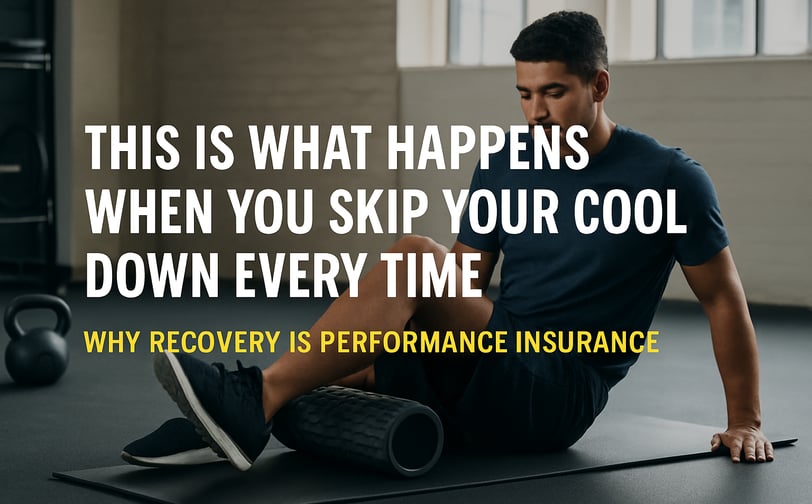What Happens When You Always Skip Your Cool Down (And How It Hurts Your Gains)
Skipping your cool down sabotages recovery, increases soreness, and limits long-term gains. Learn the science-backed reasons why recovery is performance insurance—and the tools that help you bounce back faster.
5/28/20253 min read


This Is What Happens When You Skip Your Cool Down Every Time
Why Recovery Is the Real Key to Performance Longevity
You crushed your workout, pushed through the pain, and now all you want to do is head home. No time for stretching or slowing your heart rate—you’re out the door. But here’s the truth: every time you skip your cool down, you’re quietly sabotaging your performance, recovery, and long-term progress.
Cooling down isn’t optional—it’s performance insurance. Whether you’re a serious athlete or just trying to stay healthy, ending your workout properly could mean the difference between staying pain-free or battling injury, between recovering fast or staying sore for days.
What Really Happens When You Skip Your Cool Down
Skipping your cool down disrupts multiple physiological systems at once. Let’s break it down:
Blood Pooling: After intense effort, blood gets shunted to working muscles. Without a gradual return to baseline, it can pool in your legs, causing lightheadedness or even fainting.
Stiffness and DOMS (Delayed Onset Muscle Soreness): Gentle post-workout movement helps flush out metabolic waste. No cool down means increased soreness the next day.
Reduced Heart Rate Recovery: Cooling down gradually brings your heart rate and breathing back to resting levels, which supports cardiovascular health.
Missed Mobility Opportunity: Muscles are warm and pliable post-exercise—perfect conditions for mobility work. If you skip that window, you miss a key opportunity for progress.
A 2018 study published in Frontiers in Physiology showed that active recovery (like low-intensity movement and stretching) helps remove lactate faster than passive recovery, leading to better performance in following sessions (source).
Why Cooling Down Affects Performance
Cooling down isn’t just about recovery—it’s about priming your nervous system for the next session. When you recover properly:
You reduce inflammation.
You improve flexibility and joint range of motion.
You lower stress hormone levels (like cortisol) faster.
You set your body up to bounce back stronger.
Athletes like LeBron James and Serena Williams are known for how seriously they take recovery—not just because it feels good, but because it’s strategic. It's how you stay consistent and prevent setbacks.
Product Toolbox: The Recovery Must-Have
TriggerPoint GRID Foam Roller
✅ Textured surface for deep tissue massage
✅ Improves circulation and muscle elasticity
✅ Lightweight and portable
⭐ 4.7 stars with 19,000+ reviews
Foam rolling right after training boosts circulation and helps reduce DOMS. Just 5 minutes on major muscle groups post-session can make a huge difference.
The Mental Side of Skipping Recovery
It’s easy to think “I’ll do it tomorrow” when it comes to mobility or stretching. But skipping your cool down sets a precedent that your recovery doesn’t matter. And over time, that mindset can lead to burnout, injury, or chronic tightness that limits performance.
Psychologically, a proper cool down can also help bring you back to a calm, parasympathetic state. That’s when your body truly starts to repair. In a way, your cool down isn’t just for your muscles—it’s for your mind too.
Product Toolbox: Deep Relief for Tight Spots
Theragun Mini – Handheld Percussion Massager
✅ Compact but powerful
✅ 3 speed settings
✅ Great for hips, quads, and shoulders
⭐ 4.5 stars with 4,000+ reviews
Using a massage gun right after intense training helps reduce soreness, target trigger points, and stimulate recovery at a deeper level.
How to Cool Down the Right Way
You don’t need 30 minutes. Just a focused 8–12 minutes can make all the difference. Here’s a simple cool down structure:
Light cardio (3–5 minutes) – Slow jogging, walking, or cycling to gradually bring down your heart rate.
Dynamic stretches (3 minutes) – Arm circles, leg swings, hip openers.
Static stretching (5–8 minutes) – Focus on quads, hamstrings, calves, and back. Hold each stretch for 20–30 seconds.
Add a tool if needed – Use your foam roller, massage gun, or compression gear on tight or sore spots.
Done right, you’ll finish feeling refreshed—not just wrecked.
Product we recommend: Compression to Lock In Recovery
Run Forever Sports Compression Calf Sleeves
✅ Supports blood flow and reduces fatigue
✅ Great for runners and lifters alike
✅ Helps speed up recovery post-training
⭐ 4.5 stars with 10,000+ reviews
Slide these on post-session and let your legs recover while you move through the rest of your day. Perfect for preventing shin splints and leg fatigue.
The Bottom Line
Skipping your cool down once or twice won’t ruin your progress. But doing it consistently? That adds up. Tight hips become injuries. Sore shoulders become chronic. Poor recovery becomes poor performance.
Recovery isn’t downtime—it’s part of the grind. Cooling down is one of the simplest ways to protect your investment in training. Take it seriously and you’ll feel the difference not just in the next session, but in your long-term gains.
FITNESS
Nutrition
WellnesS
info@movebetterco.com
© 2025. All rights reserved | Privacy Policy | Terms & Conditions